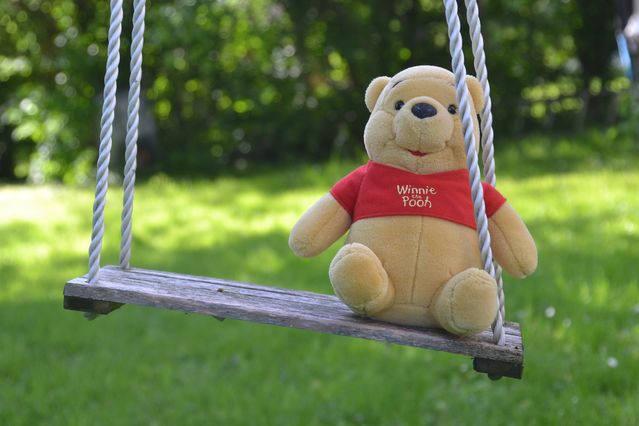Trauma
Want to Understand Trauma and PTSD? Read Winnie the Pooh
The book's beloved characters illustrate the impact of traumatic experiences.
Posted August 13, 2019 Reviewed by Devon Frye

There is no bigger joy than when our beloved childhood books continue to teach us about life even in adulthood. (OK, maybe there are bigger joys, but this comes pretty close.) Yesterday, in Part One of this series, we discovered how A. A. Milne’s military service may have, at least partially, inspired the writing of a certain bear and his loyal friends’ characters. In fact, Winnie the Pooh can teach us all about the aftermath of traumatic events.
For clinicians like myself, the books underscore the importance of looking at one’s experiences collectively, in order to better diagnose and treat those who trust us to help them. For the wider audience, like yourselves, the dwellers of the Hundred Acre Wood can offer unique insight into what it is like to live with symptoms of PTSD.
Whether that’s you or someone you love, a neighbor, a war veteran, or a friend coming out of an abusive relationship, we all gain more from knowledge. Each animal in our beloved cast of characters represents characteristics consistent with a trauma response, but not everyone who contends with PTSD will have all symptoms. You may see yourself more in Piglet and less in Owl, or more in Eeyore. Or you may be a different character every day, depending on the circumstances and stressors of your environment.
A Cast of Our Beloved Characters
Piglet
Piglet is a representation of the anxiety and hypervigilance that commonly arise in the aftermath of trauma. Adverse experiences overwhelm the nervous system, leaving us in a perpetual state of anticipating danger. Loud noises may startle us more than before the traumatic event took place. Tight spaces may seem tighter, eliciting increased heart rate. The whole world may seem as if hidden dangers are lurking from behind every corner. Trauma can leave us feeling like we have to constantly watch our back, waiting for the other shoe to drop.
What is more, Piglet also experiences significant social anxiety. This is not uncommon when the trauma we have experienced is interpersonal in nature. Once we have been hurt or betrayed by others, especially those who had a caregiving or intimate role in our lives (e.g. parents, grandparents, siblings, romantic partners), we may react by automatically becoming suspicious or even frightened by emotional closeness.
On the one hand, we may become untrusting and guarded, while, on the other hand, constantly seek reassurance. ("Pooh!" he whispered. "Yes, Piglet?" "Nothing," said Piglet, taking Pooh's paw. "I just wanted to be sure of you.")
Tigger
If asked to describe Tigger, the first thing that comes to mind is that he is constantly bouncing around. He is impulsive and sometimes rather reckless. He is unsettled and hyperactive. Rather than simply describing him as having ADHD, I argue that Tigger is experiencing some of the arousal and reactivity symptoms of PTSD. Difficulty concentrating, for example, and constantly feeling like your mind is racing, moving faster than your ability to catch it, is a prominent feature of the trauma response.
In addition, impulsivity and engaging in risky behaviors are also recognized as symptoms of PTSD. For someone who has survived a life-threatening or terrifying situation, survival guilt may also lead to daring fate.
Eeyore
“Could be worse. Not sure how, but it could be,” is quintessential Eeyore—depressed, kind of gloomy, and unable to experience joy. Eeyore illustrates several cognitive and emotional symptoms of PTSD. On the one hand, trauma can impact the ways in which we view the world, others, and ourselves. Eeyore is perpetually self-critical and surprised that his friends care about him. He also finds it much easier to withdraw from social interactions than to seek them.
On the other hand, the aftermath of trauma can leave us feeling ashamed, alone, and drowning in self-criticism, much like self-deprecating Eeyore. In addition, it can rob us of the experience of joy or pleasure, even in activities that we used to enjoy before the trauma occurred.
These are some of the most prominent, and also most insidious consequences of trauma. They can color our whole view of ourselves and others, leaving us feeling sure the world is an awful, gloomy, barren place, devoid of joy, and that we are never going to be unable to experience love or happiness again. Not infrequently, these consequences are accompanied by a sort of cynicism, also evident in Eeyore’s dry wit (“It’s not much of a tail, but I’m sort of attached to it.”)
Rabbit
Oh, poor, busy, impatient Rabbit! In this character, Milne vividly illustrated several possible consequences of trauma—an obsession with rules, inflexibility, and irritability. At first glance, they are not characteristics that endear us to Rabbit. However, consider their roots: Traumatic events inherently threaten our understanding of the world and world order; they are frequently unpredictable or terrifying, leaving (emotional) chaos in their trail.
It is not uncommon, then, to see people who have been traumatized become more rigid in their insistence on order and predictability, or irritable when such does not exist. The obsession with rules and regulations serves a purpose to ward off the existential anxiety that if rules do not exist or are not followed to the letter, a new and overwhelming catastrophe may occur.
Owl
And then, there is Owl, sitting atop his house on a tall, tall tree. He pontificates and lectures, seemingly oblivious to the impact of his long speeches on his friends. Owl has been described as dyslexic in some analyses of the Hundred Acre Wood characters. But here, I direct your attention to the more subtle dynamic that Owl creates—through his air of superiority and his patronizing approach, Owl is really demonstrating his own difficulties with intimacy. He is aloof and can only connect through intellectualizing, which is in stark contrast to his friends.
This kind of difficulty is not uncommon in individuals struggling with PTSD. The internal energy and resources it takes to manage anxiety can frequently cause one to feel so emotionally exhausted, that no room is left for genuine intimacy and connectedness. In fact, withdrawal and isolation, physical or emotional, are a hallmark symptom of PTSD. And so are the loss of playfulness, imagination, and creativity, seen in both Owl and Rabbit.
And then…there is the main hero himself:
Pooh
It is not easy to characterize Pooh in a single sentence, and I do not believe that his inattentiveness can simply be attributed to ADHD, inattentive type. Pooh is lovable, yet can be naïve and a bit scattered. He has to remind himself to stay grounded and “think, think, think.” Add to that a single-track mind for chasing honey pots, and we have a picture that very much resembles what we call dissociation.
Dissociation is not a primary symptom of PTSD, but rather a sort of quality of our presence of mind. The mind resorts to “dis-associating” itself from reality, or from a traumatic situation, so to speak, when the situation is so unbearable that the alternative is to lose one’s mind. Simply put, when our body cannot leave the traumatic situation, the mind does, in order to protect us. Many trauma survivors report that they left their bodies during the experience, that they observed themselves from afar, or that the world simply did not seem real at the time of the event.
In the aftermath of trauma, once the mind has resorted to dissociation, it may become a frequently used coping strategy, especially when triggers are present in the environment. It is as if your unconscious notices something that it reads as dangerous, and immediately alters your presence of mind.
Some of us may experience this as physical symptoms of unease, or cognitive symptoms of feeling like our mind is fragmented or hard to reign in (“think, think, think”). Others may go to greater lengths and engage in behaviors that result in somewhat altered states of mind in order to avoid painful emotions, and not even know they are doing it. An obvious strategy is using alcohol or drugs. Less obvious ones are preoccupation with food or exercise, for example.
The Bigger Picture
When I was writing this article, I re-read every Pooh book I own. Not only is it a joy to be able to say “Do not disturb, I'm reading Winnie the Pooh for research!” but I was also reminded of why the bigger picture in mental health is important.
Some of you may say that it is unfair to “pathologize” our childhood friends, but here is how I see it: These characters are not simply a sum of symptoms, just like those of us struggling with mental health difficulties are so much more than the sum total of our difficulties. Pooh is not only obsessed with food—he is also a good friend. He is kind, funny, and adventurous. Piglet may be anxious, but he is also loyal, loving, and lovable. Tigger is hyperactive, sure, but at the same time, he is energetic and entertaining.
Taken together, all of the animals also make a creative and collaborative bunch, one capable of chasing great adventures and tackling great challenges with laughter, camaraderie, and compassion. And while living with the aftermath of trauma can be at times frightening, inconvenient, or tiring, hopefully these adorable characters will remind you to not lose sight of the forest while staring at each individual tree (symptom)—especially when times become challenging.
For Part One of this article, click HERE.





